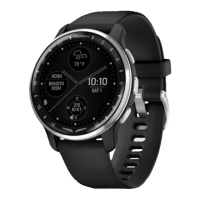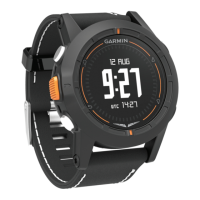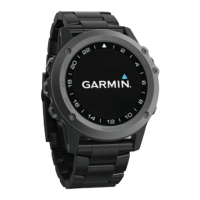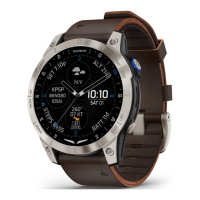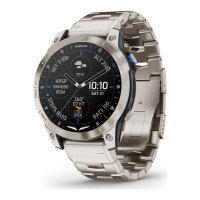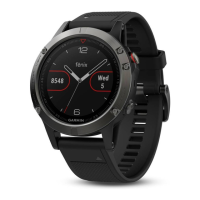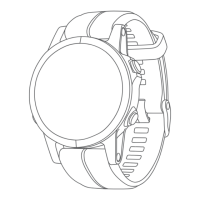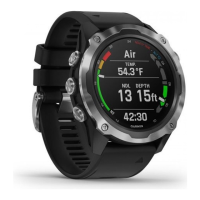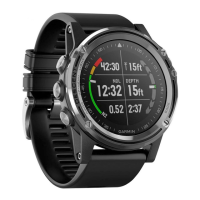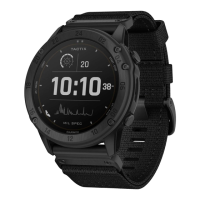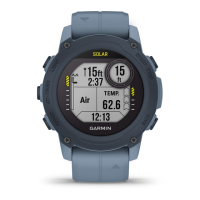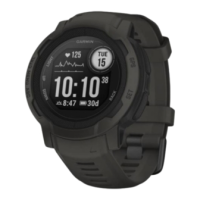Do you have a question about the Garmin D2 AIR and is the answer not in the manual?
Explains the physical components and buttons of the device.
Provides guidance on interacting with the touchscreen interface.
Accessing shortcuts and understanding device icons.
Outlines essential initial setup tasks for the D2 Air device.
Configures units, alerts, and reminders for aviation data.
Guides on setting up altitude and low oxygen alerts.
Sets pressure for altitude and fuel check reminders.
How to select airports and view METAR weather information.
Steps for navigating to waypoints, locations, and back to start.
Overview of creating, sending, and following flight plans.
How to monitor blood oxygen saturation during flight.
Steps to connect the watch to a smartphone via Garmin Connect.
How to view, manage, and configure phone notifications.
Using DND mode and locating a paired smartphone.
Using the Garmin Connect app for data and insights.
Using computer software and the Pilot app.
Overview of customizable apps, watch faces, and data fields.
Steps to connect the device to a Wi-Fi network.
Connecting third-party providers and downloading audio.
Pairing headphones and listening to music.
Explains the on-screen controls for music playback.
Steps to set up and use the Garmin Pay wallet for payments.
How to add, manage, and secure payment cards.
Features for sending emergency messages and detecting incidents.
Enabling real-time tracking and setting up contacts.
Information on the device's built-in heart rate sensor.
Understanding and configuring heart rate zones and alerts.
How to estimate and interpret VO2 Max. levels.
Taking SpO2 readings and configuring tracking.
Explains daily tracking of steps, floors, and intensity.
Monitoring sleep and earning intensity minutes.
Auto-detection of activities and tracking settings.
Browsing, adding, and reordering widgets.
Information on METAR, Altimeter, and Waypoints widgets.
Using widgets for Body Battery, Stress, and Health Stats.
Starting, stopping, and customizing activities.
Using the device for various indoor/outdoor sports.
Specifics for pool swims and golf rounds.
Managing golf courses, hazards, and scoring.
Setting up personal data and understanding fitness goals.
Using guided workouts and Garmin Connect training plans.
Marking, saving, and deleting GPS locations.
Steps for navigating to saved points and the starting point.
Using the compass and performing manual calibration.
Selecting, editing, and creating watch faces.
Customizing the quick access controls menu.
Customizing data screens, alerts, and activity settings.
Understanding GPS systems and managing phone connections.
Configuring time, alarms, timers, and display.
Adjusting display, units, and syncing settings.
Steps to connect ANT+ or Bluetooth sensors.
Using and calibrating foot pods and bike sensors.
How to charge the device and update its software.
Technical details and battery performance information.
Guidelines for cleaning the device and changing bands.
Solutions for phone, headphone, and music problems.
Addressing incorrect time display and battery life optimization.
Troubleshooting GPS reception and activity data accuracy.
Explanations of various data fields available on the device.
Explains the physical components and buttons of the device.
Provides guidance on interacting with the touchscreen interface.
Accessing shortcuts and understanding device icons.
Outlines essential initial setup tasks for the D2 Air device.
Configures units, alerts, and reminders for aviation data.
Guides on setting up altitude and low oxygen alerts.
Sets pressure for altitude and fuel check reminders.
How to select airports and view METAR weather information.
Steps for navigating to waypoints, locations, and back to start.
Overview of creating, sending, and following flight plans.
How to monitor blood oxygen saturation during flight.
Steps to connect the watch to a smartphone via Garmin Connect.
How to view, manage, and configure phone notifications.
Using DND mode and locating a paired smartphone.
Using the Garmin Connect app for data and insights.
Using computer software and the Pilot app.
Overview of customizable apps, watch faces, and data fields.
Steps to connect the device to a Wi-Fi network.
Connecting third-party providers and downloading audio.
Pairing headphones and listening to music.
Explains the on-screen controls for music playback.
Steps to set up and use the Garmin Pay wallet for payments.
How to add, manage, and secure payment cards.
Features for sending emergency messages and detecting incidents.
Enabling real-time tracking and setting up contacts.
Information on the device's built-in heart rate sensor.
Understanding and configuring heart rate zones and alerts.
How to estimate and interpret VO2 Max. levels.
Taking SpO2 readings and configuring tracking.
Explains daily tracking of steps, floors, and intensity.
Monitoring sleep and earning intensity minutes.
Auto-detection of activities and tracking settings.
Browsing, adding, and reordering widgets.
Information on METAR, Altimeter, and Waypoints widgets.
Using widgets for Body Battery, Stress, and Health Stats.
Starting, stopping, and customizing activities.
Using the device for various indoor/outdoor sports.
Specifics for pool swims and golf rounds.
Managing golf courses, hazards, and scoring.
Setting up personal data and understanding fitness goals.
Using guided workouts and Garmin Connect training plans.
Marking, saving, and deleting GPS locations.
Steps for navigating to saved points and the starting point.
Using the compass and performing manual calibration.
Selecting, editing, and creating watch faces.
Customizing the quick access controls menu.
Customizing data screens, alerts, and activity settings.
Understanding GPS systems and managing phone connections.
Configuring time, alarms, timers, and display.
Adjusting display, units, and syncing settings.
Steps to connect ANT+ or Bluetooth sensors.
Using and calibrating foot pods and bike sensors.
How to charge the device and update its software.
Technical details and battery performance information.
Guidelines for cleaning the device and changing bands.
Solutions for phone, headphone, and music problems.
Addressing incorrect time display and battery life optimization.
Troubleshooting GPS reception and activity data accuracy.
Explanations of various data fields available on the device.
| Smart notifications | Yes |
|---|---|
| Display type | Digital |
| Display diagonal | 1.2 \ |
| Watch glass type | Corning Gorilla Glass 3 |
| Display resolution | 390 x 390 pixels |
| Display technology | AMOLED |
| Shape | Round |
| Band size | - |
| Band color | Black, Stainless steel |
| Band material | Leather, Polymer |
| Watch case size | 43 mm |
| Water resistance | 5 ATM |
| Market positioning | Smartwatch |
| Watch case material | Polymer, Stainless steel |
| Battery capacity | - mAh |
| Battery life (max) | 120 h |
| Battery life (GPS mode) | 6 h |
| Mobile operating systems supported | Android, iOS |
| Width | 43.2 mm |
|---|---|
| Weight | 46.4 g |
| Thickness | 12.4 mm |
